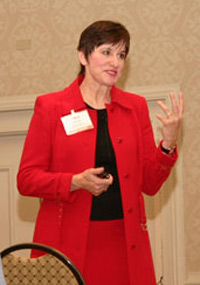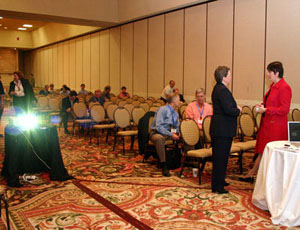Article
Janelle Barlow addresses the importance of branding in self-service
The author of the best selling "A Complaint is a Gift" and "Branded Customer Service" gave the keynote address at The Self-Service & Kiosk Show, Feb. 14, 2006. Dr. Barlow discussed what exactly brands are, why they are so important, and how to make self-service a part of an overall branding strategy.
February 13, 2006 by James Bickers — Editor, Networld Alliance
Most consumers are unaware of the careful planning that goes into the design, packaging and marketing of the products and services they enjoy. Most of them don't know why they feel comfortable when they walk into a Starbucks; they just know that they do.
Janelle Barlow, Ph.D., says this non-tangible, hard-to-quantify relationship between consumers and the products and services they buy is at the core of a successful business.
"(A brand is) primarily an emotional process of engagement," she said in her keynote address at The Self-Service & Kiosk Show on Feb. 14, 2006. "Branding is about 95 percent emotional, and a large part of that 95 percent is at an unconscious level."
To make her point, she echoed a number of quotes from business leaders, including this provocative thought from Virgin's Richard Branson: "I'm convinced that it is feelings - and feelings alone - that account for the success of the Virgin brand."
That's a tough pill to swallow for those who would like to believe it is their product, or their hard work, that should get the credit for success.
Measuring customer service
Customer service and the (hopefully) resultant satisfaction are primary goals for any business. Typically, customer service is measured by a very basic barometer - good, bad, or some combination of the two.
Barlow said that entire yardstick can be thrown out, in favor of a more brand-centric one.
"All of us are involved with service in one way or another. Instead of good service or bad service, start asking whether your service is on-brand or off-brand."

She emphasized that "satisfied customers" are no longer enough, since companies have trained individuals to equate "satisfaction" with "average."
"We've taught customers to say they're satisfied when nothing happens," she said. "Satisfaction does not get loyalty today. We have taught people to say they're satisfied - it is hard to get low marks on customer service."
That lesson extends to self-service devices, where functionality is no longer enough. Kiosks must fit with the company's overall brand, make sense aesthetically and logistically, and provide an emotional experience to the user that goes far beyond any mere transaction.
"The functionality of your devices - pretty similar, right? So the question is, what's different? That's really your strength. Inside an industry, functionality is really not going to be that different."
She said any self-service device must contain three branding "power tools": likeability, reinforcement, and consistency.
"I don't think kiosks can just be boxes of functionality. They have to be likable. You have to look at them and like them, or else people will walk away. Everything about them needs to reinforce the message. And they need to be consistent.
"Think about your brand as a promise that you deliver consistently to a defined marketplace, and your self-service project as primarily an entry point to this promise."
Her vision for the future
In an interview after her address, Dr. Barlow expressed both admiration for the industry as it was represented on the show floor, and the need for that industry to catch up from a branding and design perspective.
"The word that so resonates with me is potential," she said. "I can see it in the designs. In a very short period of time, many of these devices are going to look like they belong in an antique shop. Â… I don't know exactly what it's going to look like, but it's not going to look like this. Maybe it's because I'm looking at design elements from so many other industries, but these people are behind on design."
Barlow said she feels the industry has not yet come to grips with the integration of human interactions with the machine transaction. She said she sees great potential in environments where the customer uses both a machine and the services of a human being, so the customer service provider is freed up to do the interactive relationship building.

"An awful lot of service providers have been asked to be transaction-focused and at the same time be relationship-focused, and it's hard to do that," she said. "I think it's why so many women are in the service sector, because most women can multitask better compared to most men."
Barlow acknowledged that some industries have been reluctant to dive into self-service, perhaps hoping to watch someone else test the waters. She said that makes sense in a few circumstances, but more often than not can be perilous.
"It depends in part on how big you are," she said. "I was always struck by Bank of America, that they were the last to incorporate new changes - because they were this huge ship, and it was hard to turn it. I think that's a reasonable position for a gigantic company to take. Or, say they're going to deploy in two or three locations.
"But if you wait too long, you will get behind the curve. You don't want to do that in business today."










